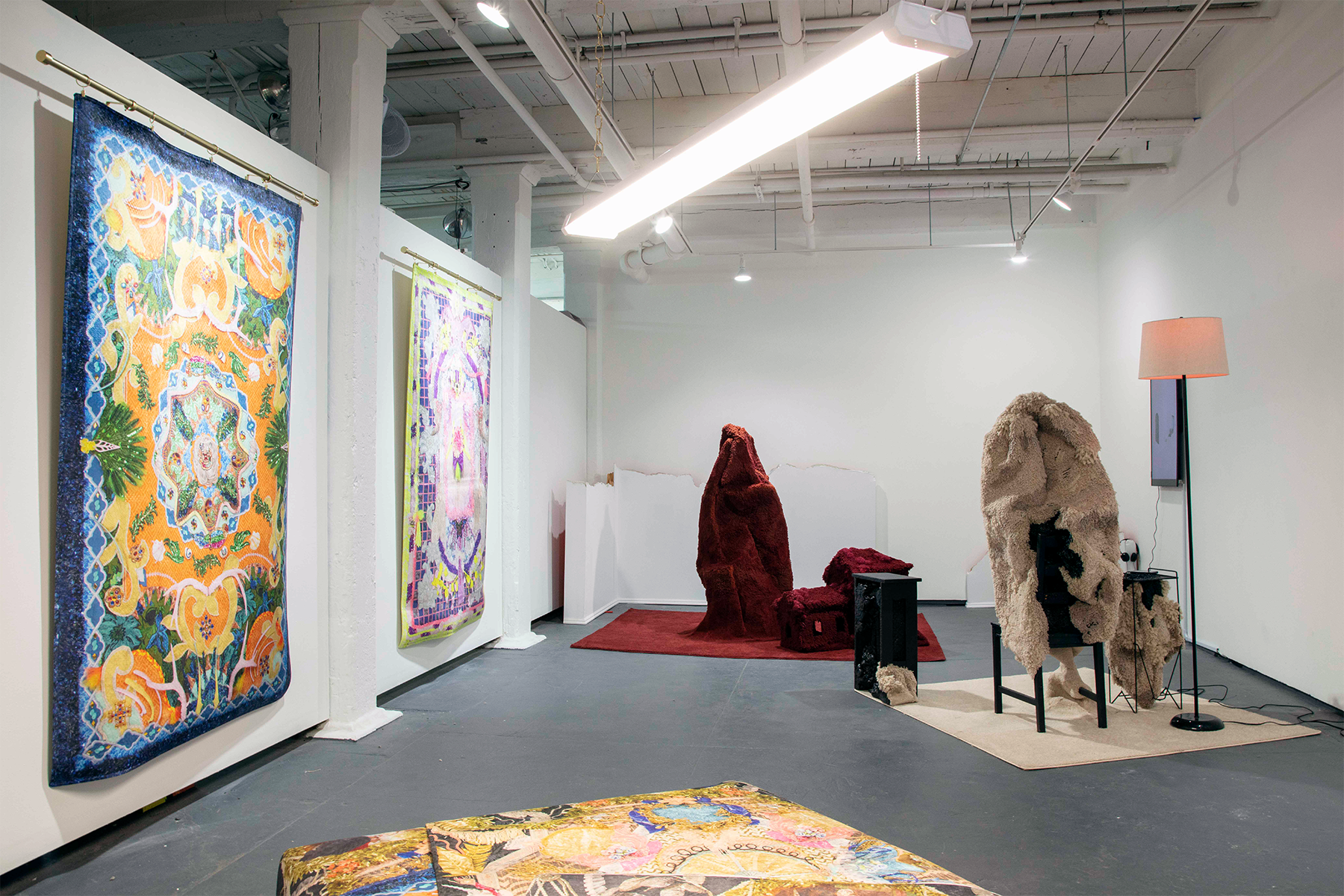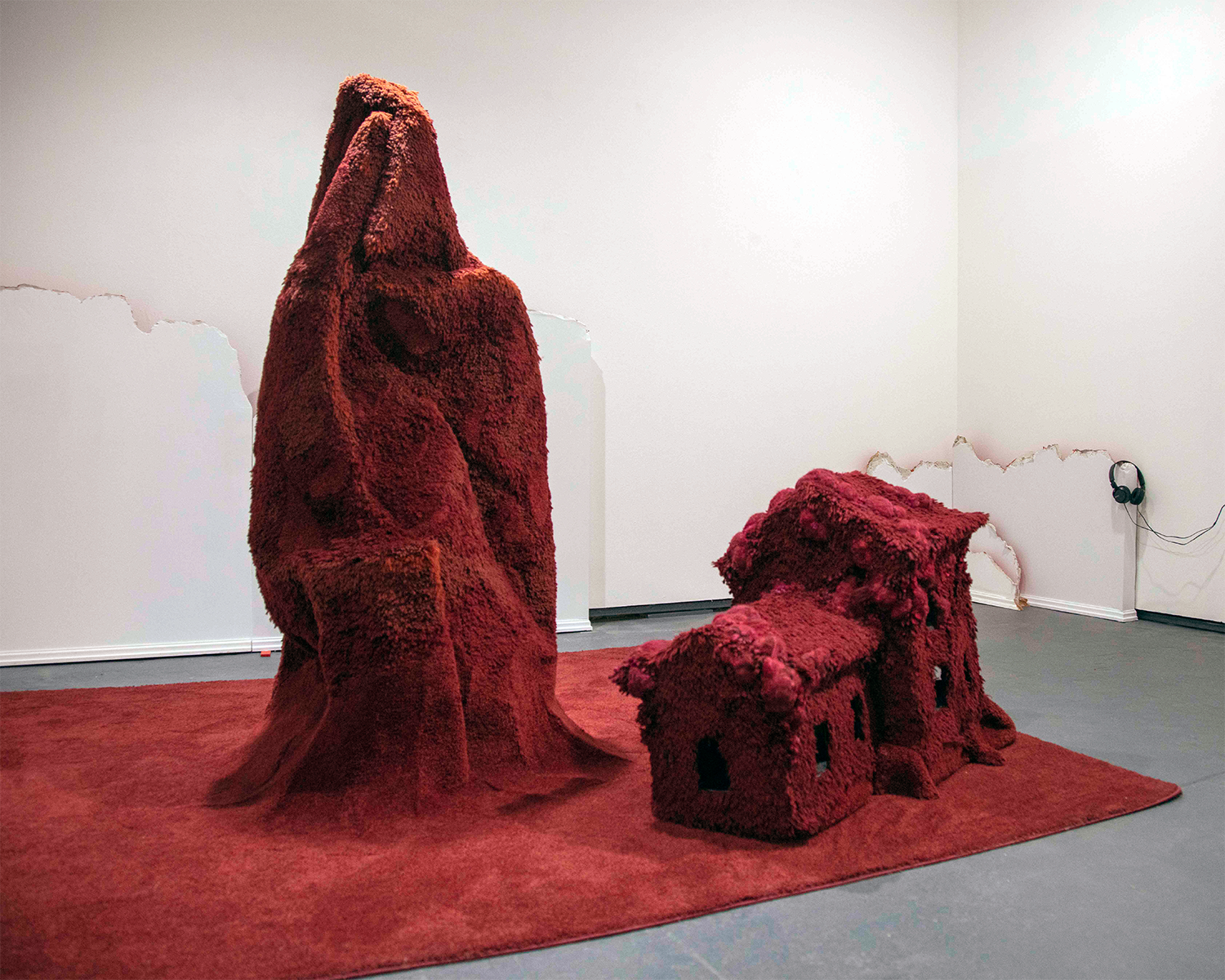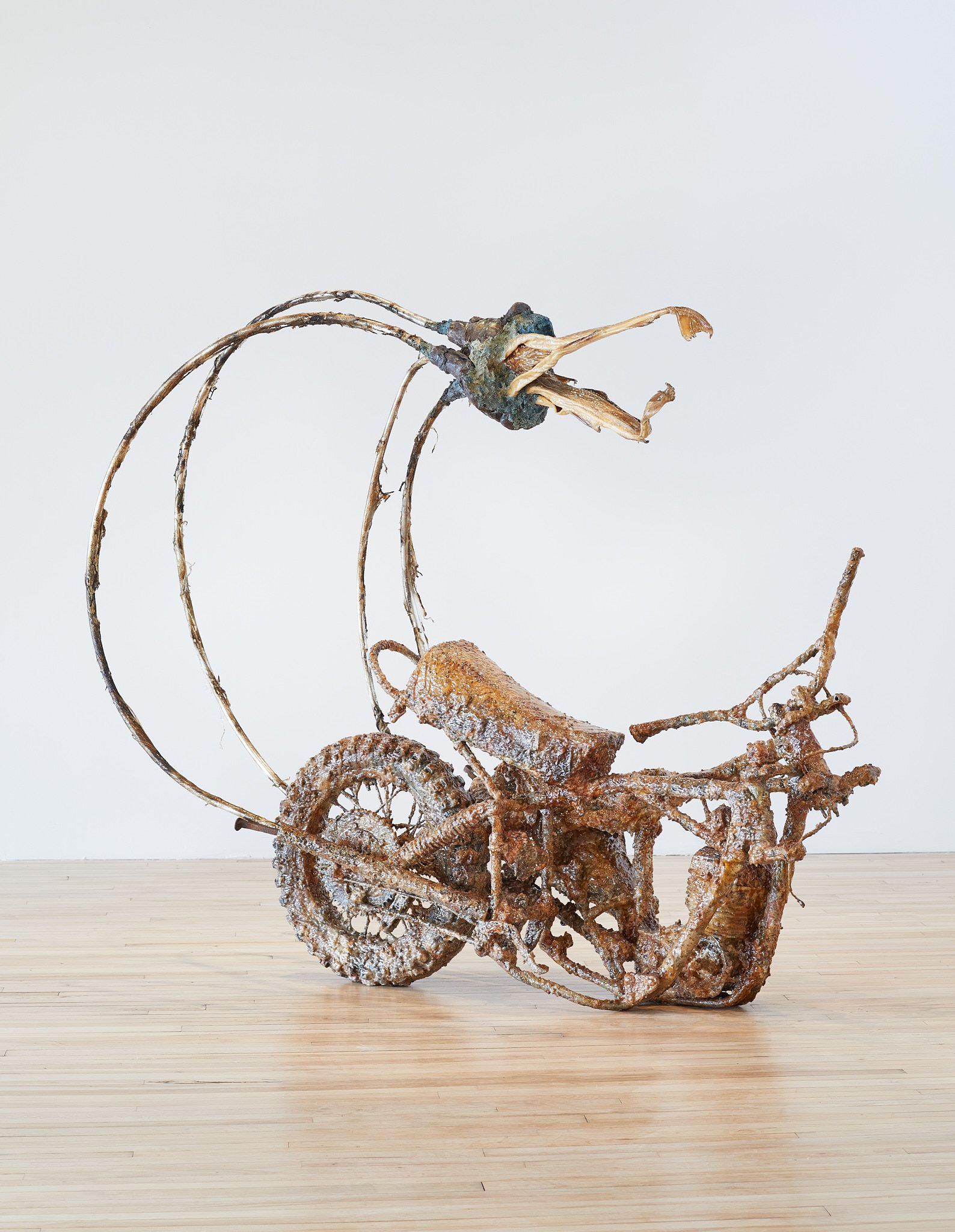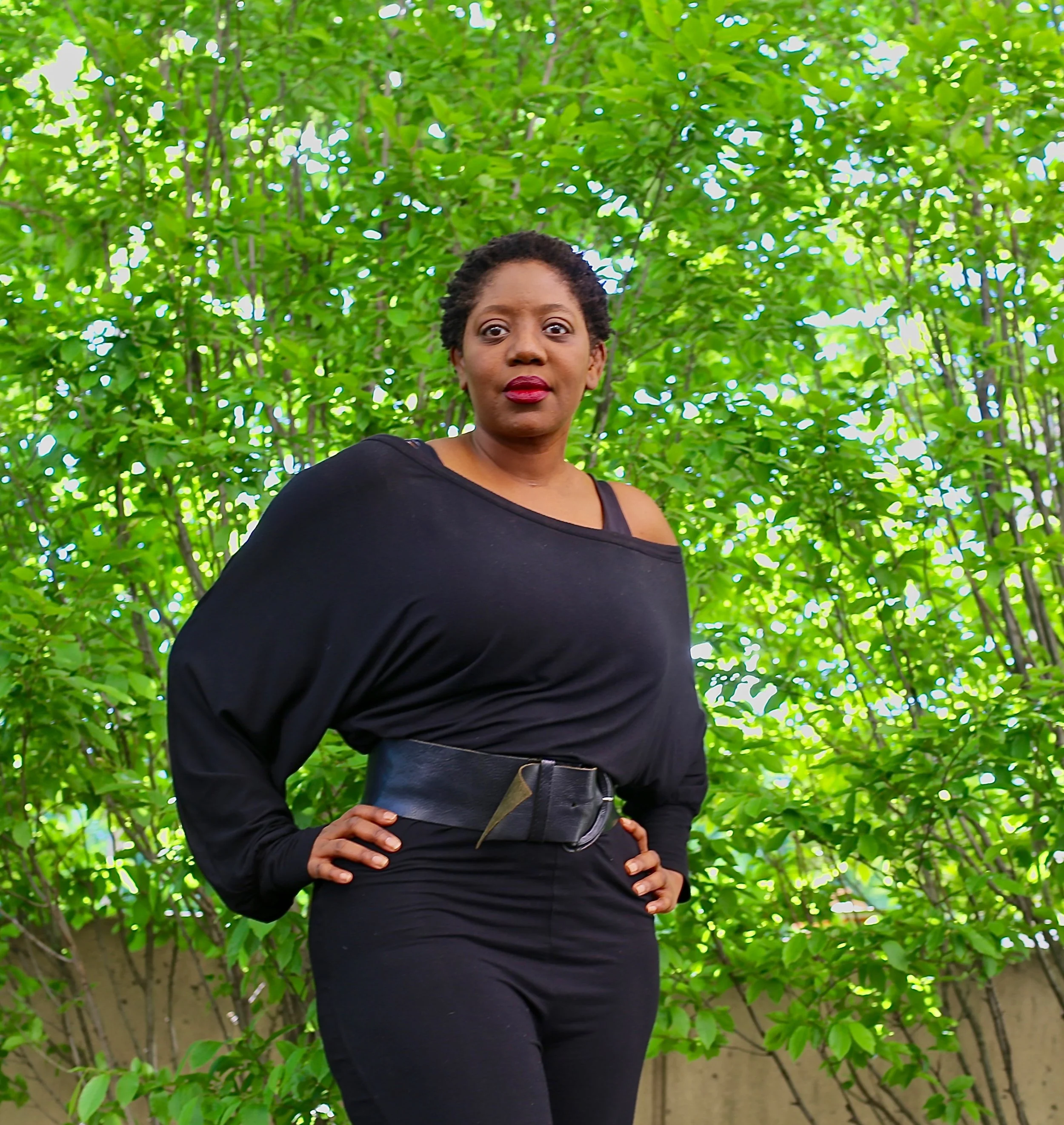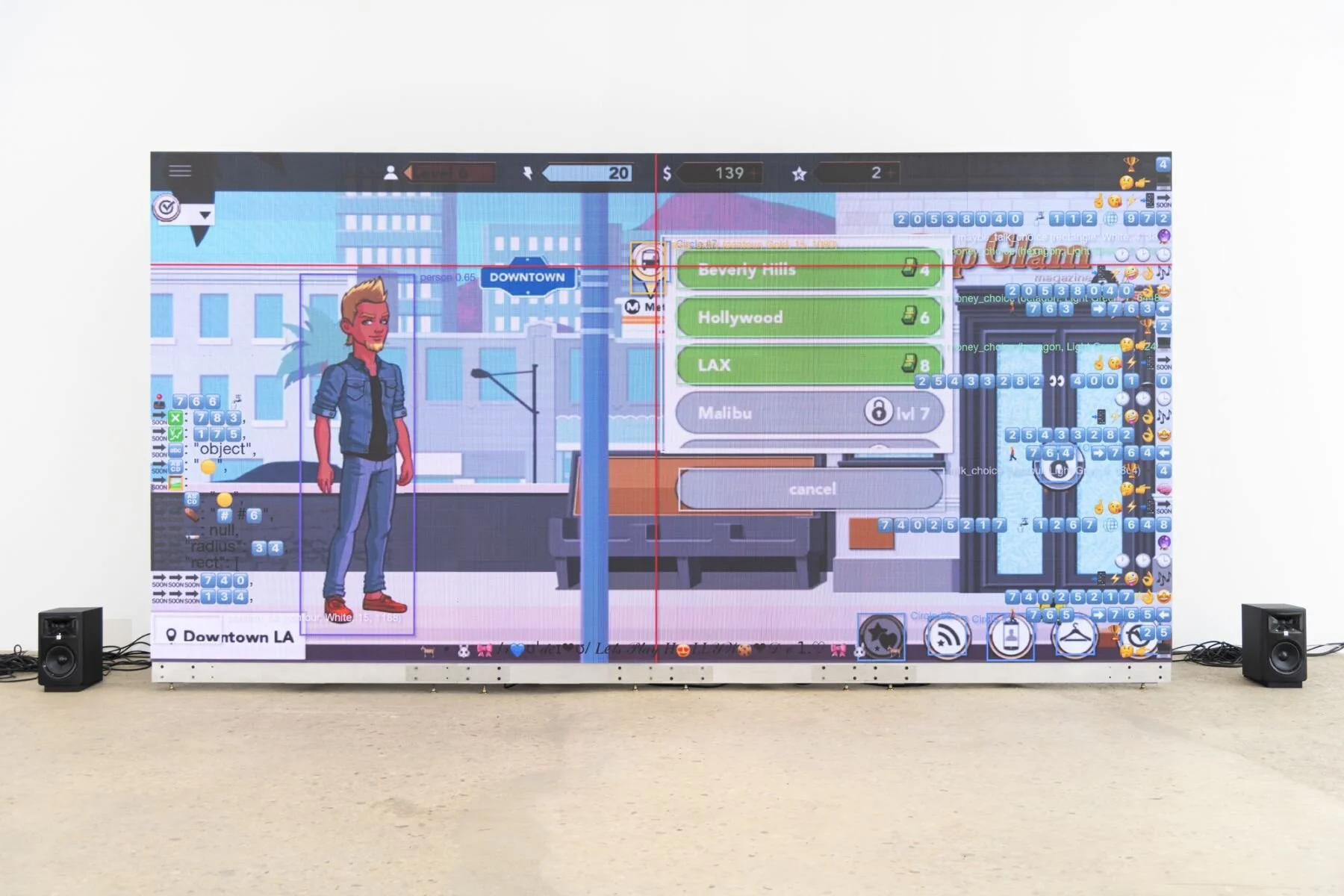Underbelly of the Beast
Installation view.
Kat Ryals and Kate Stone once described their two-person exhibition at Ortega y Gasset, Swallowed into the Soft Underbelly, as theme park meets haunted house. The intoxication of excess cannot permanently hide the creeping decay in our interiors. Our homes, the space where we have the most autonomy, became our prisons during the early pandemic. We found new areas or remade our domains. During our isolation, we continued to consume, bringing our behavior online and indoors, buying more and more stuff without the judgment of outsiders, other than delivery people urinating in bottles to feed our insatiable appetites. We shopped as we watched and judged the Hoarders without any self-awareness or a sense of identification and impending dread.
Installation view.
The red walls suggest a throat or birth canal. The latter sent my mind to the Succession episode in which Kendall Roy forced his birthday party guests to walk through a pink tunnel, supposedly a giant replica of his mother's vagina. The dark red on the gallery walls, a departure from Succession's pussy-hat pink, suggests a darker passage. I imagine the red walls of a throat as it swallows. I am about to fall into a pit of acid.
I pass through the dark-red, narrow passage, turn a corner and emerge into a vast, brightly-lit chamber, a uterus or stomach – The Belly of the Beast. Hell is a carpet showroom with fluorescent lighting emitting that all too familiar institutional buzz heard in the DMV, high schools, and prisons. An expansive inventory of collaged rugs hangs from the walls like tapestries and lay stacked upon pallets in the middle of the room.
Kat Ryals, All Sizzle and No Steak, 2022, Custom Print on Velvet Rug, 24 x 114 in., edition of 3 + 1 AP.
Rug store sample cards display the objects from the collages, including the latex-cast plants that appear in the wallpaper, Garden in Hell (2022). In contrast, Kat Stone's still and video representations of collaged environments appear minimal, with a neutral palette and an abundance of white, negative space. Ryals's rug designs touch upon a variety of Vegas-centric themes of fakery and instant gratification, such as drive-thru weddings in Drive-Thru Trianon and buffets in Surf N Turf Special (All You Can Eat). The antlers and shells lay bare the aftermath of a feast. The artist says that the work is a nod to the buffets at Excalibur and Circus Circus, the simulacra of medieval tournaments and travelling shows. The runner on the floor, All Sizzle and No Steak (2022), may refer Vegas’s legendary mafia-frequented steakhouses and contemporary establishments that try to cash in on the legend. Once seen as a luxury food, steak has been packaged and priced for mass consumption, here laid bare as a stripped carcass after a feast – vertebrae, pelvis, and hide adorned with ribbons, trim, and pearls.
Kat Ryals, Drive-Thru Trianon, 2022, Custom Print on Velvet Rug, 50 x 78 in., edition of 3 + 1 AP.
The rugs speak to fast fashion's ability to replicate handmade luxury goods once commissioned by a king. The artist collects bits and pieces, odds and ends and gifts from friends. The rugs are collaged at scale before being photographed, edited, and printed on a shimmery velvet fabric. The photograph flattens the collage elements, resulting in a trompe l'oeil effect. Ryals found her inspiration in Savonnerie rugs at Versailles woven with symbols of the absolute power and wealth of the monarchy.
Versailles and Vegas: these two locations and two moments in time recall the lotus-eaters from Homer's Odyssey, who lived on an island dominated by the lotus tree. The narcotic effect of its fruit and flowers made the lotus-eaters sleep the days away, forget their home and loved ones, and only long to stay with their fellow lotus-eaters. In Versailles, the monarchy separated themselves from the people and their suffering by escaping to a lavish pleasure palace. In casinos there are no clocks or windows to provide a connection to the outside world, keeping gamblers suspended in space and time with no desire to return. in the real world, there is always a rude awakening. For Louis XV and Marie Antionette, it was the French Revolution and the guillotine. In Vegas, it means going bust — losing it all. Stark reality eventually finds a way to intrude on even the most lavish fantasy.
Kat Ryals, Surf N Turf Special (All You Can Eat), 2022, Custom Print on Velvet Rug, 50 x 78 in., edition of 3 + 1 AP.
Ryals’s decadent rugs are exhibited alongside works by Kate Stone that are made out of carpet. Wall-to-wall carpeting, formerly a plush luxury few could afford to maintain, has become a mundane part of the postwar American home. In Kate Stone's sculptural installations, carpet isn't just a benign product to be bought and sold. It invades the space, taking shape and taking over. The carpet's warm, comfy exterior hides its dark side, as carpets absorb the detritus of everyday life: dust, fluids, dead skin cells, insect carcasses. Stone creates a scenario in which the carpet's hunger grows out of control and creates a sentient invasive species that grows and moves. In Stone's sculpture Dust Bunnies and Mineral Patience (2020), a crimson carpet covers the objects in the room — and perhaps even its occupant — like a fungus, a mold, a slime. The latch-hook work suggests that the carpet is growing, learning, and evolving.
Left: Kate Stone, Dust Bunnies and Mineral Patience, 2020, carpet, wool, wire, wood, 6’6” x 8’ x 5’3". Right: Kate Stone, Home is a Place Where a Human Lives, 2022, carpet, wool, wire, wood, polyurethane foam, epoxy clay, acrylic paint, 34” x 18” x 24”.
Home is a Place Where a Human Lives (2022) suggests an endpoint for this unchecked growth: a model of a house completely engulfed by its carpeting, the consumer becoming the consumed. The innocent, mundane carpet is actually a horror lurking beneath one's home, like the formless mass of beetles biting and killing each other under a suburban lawn in the opening sequence of David Lynch's Blue Velvet. Likewise, the American home carries a legacy of colonial conquest, racism, and genocide. Our "happy" lives are built upon countless horrors.
Stone’s video The Night Side (2019) presents similar ominous themes of a force lurking within the walls. Animated in stop-motion, the house shifts, groans, and shakes. The interior scenes start off innocently with curtains blowing in the breeze but quickly turn threatening as strange lights glow through windows and doors, furniture overturns, and pictures fall from the walls. Not just the carpet has come to life: the entire house has a mind of its own. This is a haunted house: not one possessed by external forces of darkness but rather animated by its own history. The house is haunted by the trauma and psychological horror within its walls.
The spaces we inhabit exist in a feedback loop with ourselves. We clean, furnish, and decorate within the boundaries set by the walls and floor, and the spaces we occupy influence how we live our lives. Stone's work twists this loop, giving the space itself a say in how we are allowed to exist inside it, which means risking digestion by the carpet or spontaneously combusting in a flash of light. The external world in all its decadent glory spills over into Ryals’s rugs, flooding the interior space with signifiers of cheap wealth and glamor. The only thing missing from this carpet store in the depths of hell is muzak piped into the space: acoustic covers of the greatest hits of the ‘60s. The show’s atmosphere of horror under fluorescent lights is otherwise spot-on. It presents allegories of American consumption: the decadence of a Vegas buffet shares space with a suburban house getting devoured by its own carpeting.
Kat Ryals and Kate Stone: Swallowed Into the Soft Underbelly
Curated by Clare Britt and Tiffany Smith
April 2 to May 1, 2022
Ortega y Gasset Projects
363 3rd Avenue
Brooklyn, NY 11215

